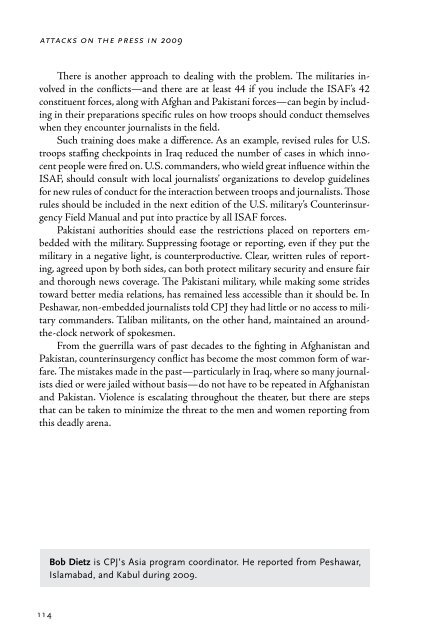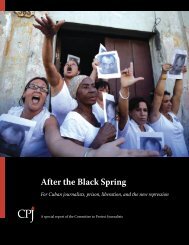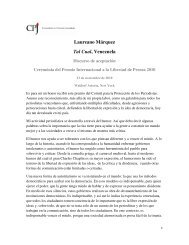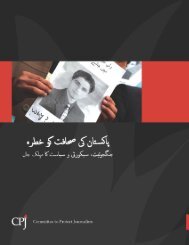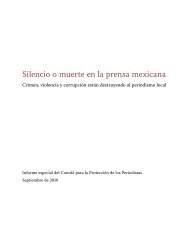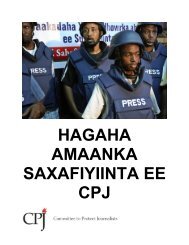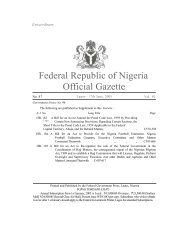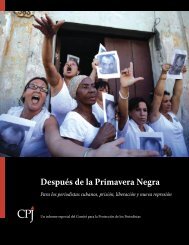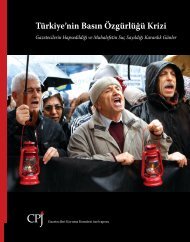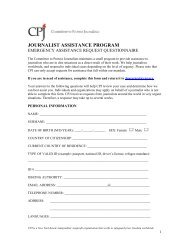Attacks on the Press - Committee to Protect Journalists
Attacks on the Press - Committee to Protect Journalists
Attacks on the Press - Committee to Protect Journalists
- No tags were found...
Create successful ePaper yourself
Turn your PDF publications into a flip-book with our unique Google optimized e-Paper software.
attacks <strong>on</strong> <strong>the</strong> press in 2009asia: afghanistanThere is ano<strong>the</strong>r approach <strong>to</strong> dealing with <strong>the</strong> problem. The militaries involvedin <strong>the</strong> c<strong>on</strong>flicts—and <strong>the</strong>re are at least 44 if you include <strong>the</strong> ISAF’s 42c<strong>on</strong>stituent forces, al<strong>on</strong>g with Afghan and Pakistani forces—can begin by includingin <strong>the</strong>ir preparati<strong>on</strong>s specific rules <strong>on</strong> how troops should c<strong>on</strong>duct <strong>the</strong>mselveswhen <strong>the</strong>y encounter journalists in <strong>the</strong> field.Such training does make a difference. As an example, revised rules for U.S.troops staffing checkpoints in Iraq reduced <strong>the</strong> number of cases in which innocentpeople were fired <strong>on</strong>. U.S. commanders, who wield great influence within <strong>the</strong>ISAF, should c<strong>on</strong>sult with local journalists’ organizati<strong>on</strong>s <strong>to</strong> develop guidelinesfor new rules of c<strong>on</strong>duct for <strong>the</strong> interacti<strong>on</strong> between troops and journalists. Thoserules should be included in <strong>the</strong> next editi<strong>on</strong> of <strong>the</strong> U.S. military’s CounterinsurgencyField Manual and put in<strong>to</strong> practice by all ISAF forces.Pakistani authorities should ease <strong>the</strong> restricti<strong>on</strong>s placed <strong>on</strong> reporters embeddedwith <strong>the</strong> military. Suppressing footage or reporting, even if <strong>the</strong>y put <strong>the</strong>military in a negative light, is counterproductive. Clear, written rules of reporting,agreed up<strong>on</strong> by both sides, can both protect military security and ensure fairand thorough news coverage. The Pakistani military, while making some strides<strong>to</strong>ward better media relati<strong>on</strong>s, has remained less accessible than it should be. InPeshawar, n<strong>on</strong>-embedded journalists <strong>to</strong>ld CPJ <strong>the</strong>y had little or no access <strong>to</strong> militarycommanders. Taliban militants, <strong>on</strong> <strong>the</strong> o<strong>the</strong>r hand, maintained an around<strong>the</strong>-clocknetwork of spokesmen.From <strong>the</strong> guerrilla wars of past decades <strong>to</strong> <strong>the</strong> fighting in Afghanistan andPakistan, counterinsurgency c<strong>on</strong>flict has become <strong>the</strong> most comm<strong>on</strong> form of warfare.The mistakes made in <strong>the</strong> past—particularly in Iraq, where so many journalistsdied or were jailed without basis—do not have <strong>to</strong> be repeated in Afghanistanand Pakistan. Violence is escalating throughout <strong>the</strong> <strong>the</strong>ater, but <strong>the</strong>re are stepsthat can be taken <strong>to</strong> minimize <strong>the</strong> threat <strong>to</strong> <strong>the</strong> men and women reporting fromthis deadly arena.AFGHANISTANDeepening violence, flawed electi<strong>on</strong>s, rampant corrupti<strong>on</strong>,and faltering development provided plenty of news <strong>to</strong> cover, but <strong>the</strong> deterioratingnati<strong>on</strong>al c<strong>on</strong>diti<strong>on</strong>s also raised dangers for local and foreign journalists workingin Afghanistan. Roadside bombs claimed <strong>the</strong> life of a Canadian reporter and injuredseveral o<strong>the</strong>r internati<strong>on</strong>al journalists. A series of kidnappings mainly targetedinternati<strong>on</strong>al reporters, butt o p developments»»Government tries <strong>to</strong> curb reporting<strong>on</strong> Electi<strong>on</strong> Day violence.»»Abducti<strong>on</strong>s target foreign reporters,endangering local journalists, <strong>to</strong>o.20key statisticYears that ParwezKambakhsh would havespent in jail <strong>on</strong> an unjust charge. Hewas freed in August.<strong>on</strong>e captive Afghan journalist waskilled during a British militarymissi<strong>on</strong> that succeeded in rescuinghis British-Irish colleague.Insurgent groups sought<strong>to</strong> disrupt <strong>the</strong> August 20 presidentialelecti<strong>on</strong>s with an arrayof bombings and o<strong>the</strong>r attacks,prompting <strong>the</strong> government <strong>to</strong> issuea directive urging news medianot <strong>to</strong> report <strong>on</strong> Electi<strong>on</strong> Day violence.Officials followed up withph<strong>on</strong>e calls seeking <strong>to</strong> discouragesuch reporting, saying <strong>the</strong> coveragewould deter turnout. Some Afghan news media t<strong>on</strong>ed down coverage in resp<strong>on</strong>se,journalists <strong>to</strong>ld CPJ, but most reported events as <strong>the</strong>y ordinarily would.“Our local members in all 34 provinces all rejected <strong>the</strong> government’s request,and we issued a statement and <strong>to</strong>ld members <strong>to</strong> c<strong>on</strong>tinue reporting all day <strong>the</strong>same way <strong>the</strong>y have in <strong>the</strong> past,” Rahimullah Samander, head of <strong>the</strong> Afghan Independent<strong>Journalists</strong> Associati<strong>on</strong>, <strong>to</strong>ld CPJ. Internati<strong>on</strong>al journalists reportedobstructi<strong>on</strong> by police seeking <strong>to</strong> enforce <strong>the</strong> directive. P.J. Tobia, a corresp<strong>on</strong>dentfor The Christian Science M<strong>on</strong>i<strong>to</strong>r, reported that police were “ripping videoand still cameras off <strong>the</strong> shoulders of pho<strong>to</strong>graphers and televisi<strong>on</strong> reporters”seeking <strong>to</strong> cover <strong>the</strong> aftermath of a Kabul firefight. At least three internati<strong>on</strong>aljournalists and several local journalists were briefly detained in various parts of<strong>the</strong> country <strong>on</strong> Electi<strong>on</strong> Day.Reports of fraud emerged as quickly as tallies showing President HamidBob Dietz is CPJ’s Asia program coordina<strong>to</strong>r. He reported from Peshawar,Islamabad, and Kabul during 2009.Country summaries in this chapter were researched and written by CPJ AsiaProgram Coordina<strong>to</strong>r Bob Dietz, Research Associate Madeline Earp, andSenior Sou<strong>the</strong>ast Asia Representative Shawn W. Crispin.114115


